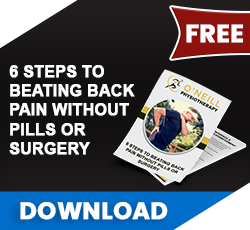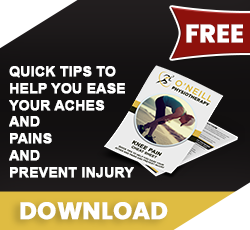Protecting Your Back During Pregnancy
There is also a hormonal softening effect that occurs. This is normal and essential for baby’s growth and safe movement through the birth canal. This also plays a part in the stretching of the abdominal muscles.
With these changes, however there is a greater chance of back pain, pelvic girdle pain or pubic symphysis pain in pregnancy or in the postpartum period.
What can I do to prevent or minimise this?
Exercise
Where possible improve your overall fitness before falling pregnancy as this will help reduce the risk of back pain and benefit you during labour and after giving birth.
Keeping fit and supple through gentle exercise is good for you, and can help to prevent back and pelvic pain. However, don’t overdo things. If something hurts when you exercise, don’t push through the pain, as it could cause injury.
Being fit before you are pregnant won’t prevent pelvic pain from happening. But if you exercise three times a week or more once you become pregnant, and throughout your pregnancy, you’ll be less likely to experience a lot of pain.
The best forms of pregnancy exercise include swimming, walking, cycling on an exercise bike, exercising on a large gym ball, aquanatal classes, pilates or yoga.
Weight gain
Be mindful of excess weight gain as your body is already having to adapt rapidly to all the changes that come with pregnancy but adding extra unnecessary weight means that there is a higher probability of developing back pain.
It is important not to diet during pregnancy so be guided by your healthcare team but eating a healthy, balanced diet and exercising regularly will help.
Sitting
Choose a comfortable chair that supports your head, back and legs. Try placing a small cushion or rolled towel in the small of your back and avoid sitting cross-legged.
A dining room chair is better for your back than a soft chair or sofa or try sitting on a large exercise ball. This promotes good posture and makes pelvic tilting easier. If you need to sit for long periods, aim to get up and move around every 30 minutes.
Change position
Getting into the all fours position can help take the pressure of the growing baby off your back. The cat stretch and rest pose are good and this is an ideal position to practice your pelvic floor and lower tummy exercises.
Bed
When lying down, especially after 16 weeks, try to lie on your left side with your knees bent up and a pillow in between them to keep the pressure off the muscles around your hips and pelvis.
Placing a wedge-shaped pillow under your bump can help support and align your body. This helps to minimise back pain or if your waist sags down, a rolled-up towel under your waist can be beneficial too.
When getting out of bed, do not jack-knife forward into the sitting position. Instead, bend your knees and roll to one side, then push up with your hands into the sitting position as you lower your legs over the edge of the bed. This will reduce the strain on your back, pelvis and tummy.
To get into bed simply reverse this movement. Use this knee bent technique to log roll from side to side when you want to change lying position too.
Rest
Too much rest can make back or pelvic pain worse. But it’s also important to rest your pelvis at regular intervals. Kneel or lean forward to protect your pelvic joints and to take the weight off your back.
Try leaning forward over a some of cushions or pillows, or an exercise ball.
Alternate between rest and activity, rather than spending long periods of time being active and long periods of time resting.
Standing and Lifting
When you are standing from a sitting position, do a few pelvic tilts first then move to the edge of the seat and stand.
When lifting and carrying all usual safe manual handling methods apply. Just be sensible with load size and back position. If you are holding your breath or straining to lift, then the load is too heavy and puts you at risk of pelvic organ prolapse and greater abdominal muscle separation as well as back pain.
Whenever possible, raise work surfaces. If you can’t, try kneeling or squatting to avoid having to bend repetitively. Bending every now and then is of course fine! Our bodies are designed to move in many directions…pregnant or not.
Try to brace your lower abdominals and pelvic floor muscles by drawing your belly button toward your spine before and during lifting. Remember to relax them afterwards too. Overworked muscles can be just as much to blame for back pain as weakened ones. If you have other children and they are able, help them to be independent. Encourage them to get in and out of the car or climb into and off your lap by themselves.
Tips to help with backache
1) Check your posture
If you stand with a forward posture it will create greater strain on your back. Try to stand upright and draw your tummy muscles inward if you need to stand in one position for a long period of time. Pull your shoulders back and tuck your chin in. Slightly bend your knees and use support of chair or table if needed.
2) Try to relax
Relaxation is an important aspect of pregnancy and helps your muscles to relax, reduce tension and improve blood flow. Aim to lie on your bed and dim the lights slightly and play some relaxing music. Starting with your shoulders, tense and consciously relax individual muscles on each side of your body. Aim to tense the muscle as your breath in and then relax the muscle as your breath out. Work down through your muscles to your legs and toes. It takes time to perfect this technique but it can be very helpful to reduce pain and stiffness in your lower back and all muscles during pregnancy.
3) Try some stretches
As we said above try gentle exercises such as the cat stretch. On your hands and knees, curl your back like a cat, hold this stretch for as long as comfortable then move back into the starting position. Repeat 6 to 8 times, providing that this feels comfortable and you get NO pain with this exercise. Do not push through pain.
4) Bend, bend, brace
Bend your knees and hips as you move to pick things up from a low height. This will save you from getting a back ache. Do not lift heavy objects and always ask for help rather than move it yourself
NOTE: If all the above suggestions are not helping and your pain is persisting or getting worse then remember to speak to your midwife or obstetrician for an appointment with a continence and women’s health physiotherapist who can fully assess you and provide treatment and recommendations to help.



